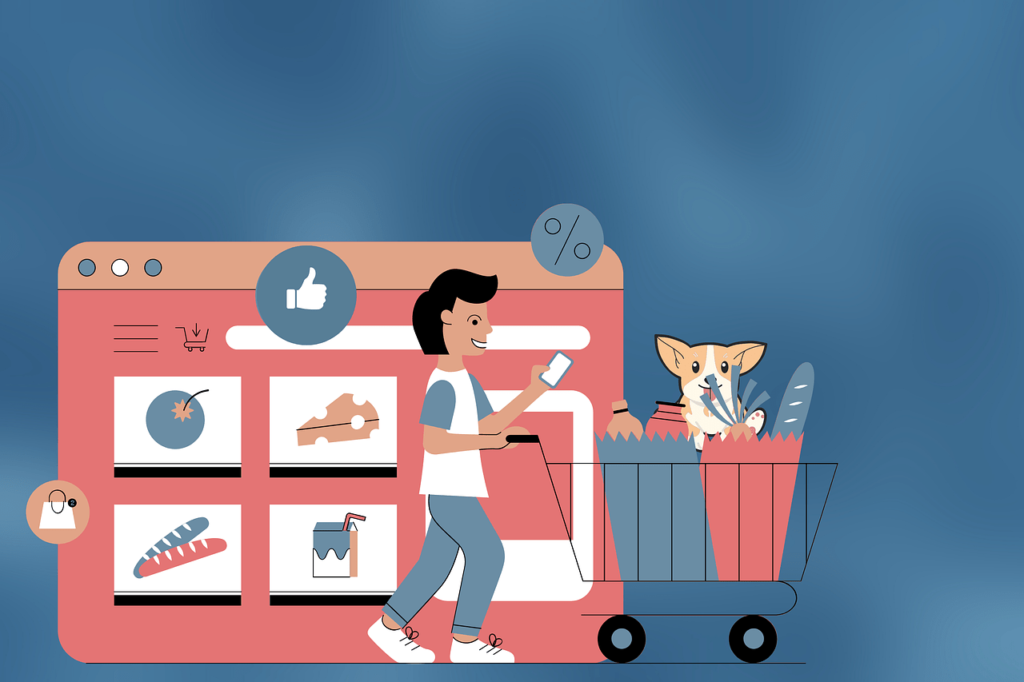Are you curious about the future of e-commerce and the trends that will shape it? Look no further! This article will provide you with a captivating overview of the key trends that are set to revolutionize the world of online shopping. Brace yourself for an exciting journey into the future of e-commerce, where new technologies, changing consumer behaviors, and innovative strategies are reshaping the industry. From the rise of voice commerce to personalized shopping experiences, get ready to discover the exciting trends that will redefine the way we shop online. So, grab your favorite beverage and get ready to explore the fascinating world of e-commerce!

Artificial Intelligence
Personalized shopping experiences
Artificial Intelligence (AI) has revolutionized the way we shop online. With advanced algorithms and machine learning capabilities, AI can analyze vast amounts of data and provide personalized shopping experiences for each individual customer. By understanding customer preferences, buying patterns, and browsing behavior, AI can suggest products that are most likely to appeal to each customer. This personalized approach not only enhances the shopping experience but also increases customer engagement and boosts sales.
Chatbots for customer service
Another area where AI has made a significant impact is customer service. Chatbots, powered by AI technology, can provide instant and efficient support to customers. These virtual assistants are available 24/7 and can handle a wide range of customer queries, from product inquiries to order tracking. They can provide real-time responses, offer personalized recommendations, and even process orders. Chatbots not only streamline customer service but also save time and resources for businesses, allowing human agents to focus on more complex inquiries.
Automated inventory management
Inventory management is a crucial aspect of running a successful e-commerce business, and AI has greatly simplified this process. AI-powered systems can analyze historical sales data, forecast demand, and automatically adjust inventory levels accordingly. This eliminates the need for manual tracking and helps businesses optimize stock levels, reducing wastage and minimizing inventory holding costs. Moreover, AI can detect trends and patterns in customer behavior, enabling businesses to better understand market demand and make informed decisions.
Mobile Shopping
Rise of mobile commerce
With the rapid advancement of technology and the widespread adoption of smartphones, mobile commerce has become increasingly popular. Consumers now have the ability to shop anytime, anywhere, directly from their mobile devices. Mobile shopping offers convenience and flexibility, allowing customers to browse products, compare prices, and make purchases with just a few taps on their screens. Retailers are capitalizing on this trend by optimizing their websites and applications for mobile devices, providing a seamless and user-friendly shopping experience.
Mobile payment solutions
As mobile commerce continues to grow, so does the need for secure and convenient payment solutions. Mobile payment options, such as digital wallets and mobile banking apps, allow customers to complete transactions quickly and securely. These solutions eliminate the need for cash or physical cards, making the checkout process smoother and more efficient. Retailers are also embracing mobile payment technologies to enhance customer experience and cater to a wider range of payment preferences.
Integration of augmented reality
Augmented Reality (AR) has the potential to revolutionize the way customers shop online. By overlaying digital information onto the real world, AR technology allows customers to visualize products in their own environments before making a purchase. For example, customers can use their smartphones to try on virtual clothing or place virtual furniture in their rooms. This immersive experience not only enhances customer engagement but also reduces the need for returns, as customers can make better-informed decisions about their purchases.
Voice Commerce
Voice assistants for online shopping
Voice assistants, such as Amazon’s Alexa or Apple’s Siri, are becoming increasingly popular for online shopping. These intelligent virtual helpers can understand and respond to voice commands, allowing customers to search for products, ask for recommendations, and even make purchases using just their voice. Voice commerce provides a hands-free and convenient shopping experience, especially for customers who prefer to multitask or have mobility limitations.
Voice-enabled product search
One of the key challenges in online shopping is finding the right products among the vast selection available. Voice-enabled product search addresses this challenge by allowing customers to simply describe what they are looking for to their voice assistant. AI algorithms then analyze the customer’s query and provide accurate and relevant search results. This streamlines the search process and helps customers find what they need more quickly and easily.
Voice-activated transactions
Voice commerce is not limited to product searches; it extends to completing transactions as well. Voice-activated transactions allow customers to make purchases using voice commands, eliminating the need for manual input or navigation. Customers can securely authorize payments using their voice, making the checkout process faster and more convenient. This technology also has the potential to enhance accessibility for customers with disabilities, making online shopping more inclusive for all.
Social Commerce
Integration of social media platforms
Social media platforms have become an integral part of our daily lives, and businesses are leveraging this popularity to drive sales. By integrating social media platforms with e-commerce websites, retailers can reach a wider audience and engage with customers in a more personalized way. Social media integration allows customers to shop directly from social media platforms, making the purchasing process seamless and convenient.
Influencer marketing
Influencer marketing has gained significant traction in recent years, and it plays a crucial role in social commerce. Influencers, with their large and loyal follower bases, have the power to influence purchasing decisions. By collaborating with influencers, businesses can promote their products to a targeted audience, leveraging the trust and credibility that influencers have built with their followers. This form of marketing not only increases brand visibility but also drives traffic and conversions.
Social buying buttons
Social buying buttons are a game-changer in social commerce, allowing customers to purchase products directly through social media platforms. These buttons enable customers to buy products they discover while browsing their favorite social media feeds, without having to navigate to a separate e-commerce website. By reducing friction in the purchasing process, social buying buttons increase impulse purchases and capitalize on the immediate interest generated by social media content.

Omnichannel Integration
Seamless shopping experiences across channels
Omnichannel integration aims to provide customers with a seamless shopping experience across multiple channels, including online and offline. This integration allows customers to start a transaction on one channel and complete it on another without any interruption. For example, customers can browse products on a retailer’s website, add items to their cart, and then seamlessly continue the process in a physical store or through a mobile application. This cohesive experience enhances customer satisfaction and fosters loyalty.
Integration of online and offline sales
The integration of online and offline sales is crucial for retailers who have both physical stores and an e-commerce presence. By syncing inventory, pricing, and customer data between the two channels, businesses can provide consistent and personalized experiences to their customers. This integration also enables customers to return products purchased online to physical stores, enhancing convenience and reducing barriers to purchase. Retailers that successfully integrate online and offline sales can leverage the strengths of both channels and drive overall sales growth.
Click-and-collect options
Click-and-collect, also known as buy online, pick up in-store (BOPIS), is an omnichannel option that allows customers to purchase products online and collect them from a physical store. This option offers customers the convenience of online shopping and the immediacy of in-store pickup. Customers can save on shipping costs and time by collecting their purchases at a convenient location and timeframe. Click-and-collect also drives foot traffic to physical stores, presenting opportunities for upselling and cross-selling.
Virtual Reality
Immersive product experiences
Virtual Reality (VR) technology has the power to transform the way customers experience products. By creating immersive virtual environments, VR allows customers to interact with products in a realistic and engaging way. For example, customers can virtually walk through a virtual showroom, examining products from every angle and experiencing their features firsthand. This immersive experience enhances customer satisfaction, reduces the need for physical showrooms, and increases confidence in purchasing decisions.
Virtual try-on for fashion and beauty
Virtual try-on is a game-changer for the fashion and beauty industry. By using facial recognition technology and AR, customers can virtually try on clothes, accessories, or makeup products before making a purchase. This eliminates the need for physical fitting rooms or trial makeup sessions, allowing customers to see how products look on them without leaving their homes. Virtual try-on not only enhances the shopping experience but also reduces returns and increases customer confidence in their purchases.
Virtual showrooms and exhibitions
Virtual showrooms and exhibitions are becoming increasingly popular, especially in industries such as home decor, furniture, and automotive. By creating virtual replicas of physical spaces, businesses can showcase their products in a visually compelling and interactive way. Customers can explore virtual showrooms, view products in different configurations, and gain a better understanding of their features and functionality. Virtual showrooms not only save businesses on the costs of physical exhibitions but also cater to customers who prefer to shop from the comfort of their own homes.

Subscription E-commerce
Rise of subscription-based services
Subscription-based services have gained immense popularity in recent years, offering customers convenience, personalized experiences, and cost savings. From monthly beauty boxes to curated clothing subscriptions, customers can have products delivered to their doorstep on a recurring basis. Subscription e-commerce not only creates a steady revenue stream for businesses but also builds customer loyalty and encourages repeat purchases. Customers value the convenience of having products automatically replenished and enjoy the element of surprise that comes with curated subscriptions.
Personalized product recommendations
Personalization is key in subscription e-commerce. By analyzing customer preferences, buying history, and feedback, businesses can curate personalized product recommendations that cater to individual tastes and needs. These recommendations ensure that customers receive products they are likely to enjoy and reduce the likelihood of churn. By continually refining recommendations based on customer feedback and preferences, businesses can further enhance customer satisfaction and loyalty.
Automatic replenishment options
Automatic replenishment takes convenience to the next level by automatically restocking products that customers use regularly. By using data analysis and AI algorithms, businesses can predict when a customer is likely to run out of a particular product and automatically ship a replacement. This eliminates the need for customers to remember to reorder and ensures a seamless and uninterrupted supply of essential products. Automatic replenishment not only saves customers time but also strengthens their relationship with the brand, as they can rely on a hassle-free shopping experience.
Green and Sustainable Practices
Eco-friendly packaging
As environmental consciousness grows, customers are becoming more concerned about the eco-friendliness of their purchases. E-commerce businesses are responding to this by adopting eco-friendly packaging solutions. From using recyclable materials to reducing excessive packaging, businesses are striving to minimize their carbon footprint and reduce waste. Eco-friendly packaging not only aligns with customer values but also contributes to a positive brand image and increases customer loyalty.
Sustainable supply chains
Sustainability goes beyond packaging; it extends to the entire supply chain. E-commerce businesses are increasingly focusing on sustainable sourcing, manufacturing, and transportation practices. This includes working with suppliers who follow ethical and sustainable practices, using renewable energy sources in manufacturing, and optimizing logistics to reduce greenhouse gas emissions. By adopting sustainable supply chain practices, businesses demonstrate their commitment to the environment and attract environmentally conscious customers.
Ethical and transparent business practices
Customers now expect businesses to operate ethically and transparently. E-commerce businesses are responding by promoting fair labor practices, ensuring the traceability of their products, and providing comprehensive information about their sourcing and manufacturing processes. This transparency builds trust with customers, who value businesses that prioritize ethical considerations. By adopting ethical and transparent business practices, e-commerce businesses can differentiate themselves from competitors and attract customers who value socially responsible shopping.

Same-day and Instant Delivery
Fast and convenient shipping options
Same-day and instant delivery options are becoming increasingly important for customers who value speed and convenience. E-commerce businesses are partnering with logistics providers to offer fast shipping options that meet these demands. With same-day delivery, customers can have their orders delivered within a few hours of placing them. Instant delivery, enabled by the use of drones or autonomous vehicles, takes speed to the next level, with products delivered almost instantaneously. These fast and convenient shipping options enhance customer satisfaction and provide a competitive advantage.
Drone and autonomous vehicle delivery
The use of drones and autonomous vehicles for delivery is a growing trend in e-commerce. These technologies allow for faster and more efficient delivery, particularly in densely populated areas. Drones and autonomous vehicles can navigate traffic easily and make deliveries to customers’ doorsteps without human intervention. This not only saves time and reduces delivery costs but also minimizes the carbon footprint associated with traditional delivery methods. As regulations evolve, we can expect to see more widespread adoption of drone and autonomous vehicle delivery.
On-demand fulfillment services
On-demand fulfillment services are becoming increasingly popular, particularly among businesses that lack their own warehousing and distribution capabilities. These services allow businesses to store their inventory in third-party warehouses and fulfill orders on an as-needed basis. On-demand fulfillment services offer businesses flexibility, scalability, and cost savings, as they eliminate the need to invest in physical infrastructure. This model also benefits customers, as it enables faster shipping and reduces the likelihood of out-of-stock scenarios.
Data-driven Personalization
Customer behavior analytics
Data-driven personalization relies on customer behavior analytics to understand individual preferences and provide customized experiences. By analyzing data such as browsing history, purchase history, and demographic information, businesses can gain insights into customer preferences and tailor their offerings accordingly. Customer behavior analytics also allow businesses to identify trends, predict demand, and optimize pricing strategies. The more businesses understand their customers, the more accurately they can personalize the shopping experience and drive customer satisfaction.
Real-time product recommendations
Real-time product recommendations are a powerful tool in data-driven personalization. By analyzing customer behavior in real-time, businesses can suggest relevant products at the right moment, increasing the likelihood of a purchase. These recommendations can be based on factors such as browsing behavior, past purchases, and preferences of similar customers. Real-time product recommendations not only enhance the customer experience but also drive cross-selling and upselling opportunities, increasing the average order value.
Dynamic pricing strategies
Dynamic pricing strategies leverage customer data and market conditions to offer personalized and optimized pricing. By analyzing factors such as customer behavior, purchase history, and competitor pricing, businesses can dynamically adjust prices to maximize revenue and profitability. This strategy allows businesses to offer targeted discounts or promotions to specific customer segments, drive demand during slow periods, and optimize pricing based on supply and demand dynamics. Dynamic pricing strategies provide value to customers while maximizing business outcomes.

